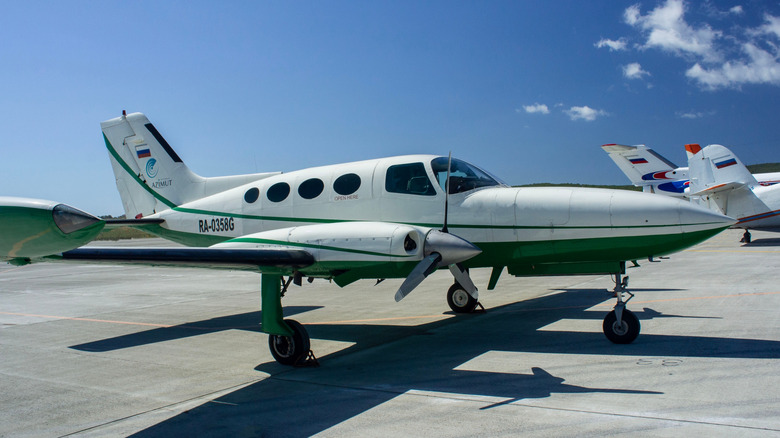5 Of The Most Famous Private Aircraft Crashes & The Technical Failures Behind Them
Private aviation, a diverse sector that extends beyond the realm of military, large-scale passenger, or commercial transport operations, offers more than just a means for the wealthy to jet-set to exotic locales. It encompasses a wide range of activities, from private recreational flying in propeller-driven Cessnas to the high-powered jet aircraft and turbine helicopters that transport VIPs and donated organs. Private jet travel differs from commercial travel, often to the traveler's benefit. Some of the fastest private jets in the world whisk VIPs to destinations in the blink of an eye.
Regulations and dutiful maintenance make flying as safe as possible — impressively so, given the number of flights that take place without a hitch daily. Aviation professionals of all types strive to minimize accidents by learning from mistakes and meticulously maintaining their certifications and aircraft.
Yet, with over 22,000 private jets (about two-thirds of which are American-owned) registered, and an untold number of privately operated helicopters and propeller aircraft accumulating millions of flight hours each year, it's a tragic fact that Murphy's Law will rear its ugly head from time to time. The costs of private aviation are such that it's a privilege typically associated with wealthy individuals. Because many high-profile individuals use private jets, some of these incidents capture the public's attention and make headlines worldwide. We explore some famous private aircraft crashes and examine the technical reasons behind the tragedy.
2008 South Carolina Learjet 60
Few embody the modern jet-set lifestyle better than the music star. Traveling between cities and continents to play shows around the world is a dream for millions. However, the high-flying lifestyle comes with its share of risks.
Travis Barker, drummer of pop-punk behemoth Blink-182, was aboard a Learjet 60 on September 19, 2008, waiting to begin the runway roll for a flight from Columbia, South Carolina, to Los Angeles, California. With him aboard were 35-year-old Adam Goldstein, known to music fans as DJ AM, and Barker's employees and friends Chris Baker, aged 29, and Charles Still, aged 25. In the cockpit, 31-year-old pilot Sarah Lemmon was at the controls alongside 52-year-old co-pilot James Bland.
Disaster struck as the Learjet, embarking on a 150 mph takeoff down an 8,000-foot runway at Columbia Metropolitan Airport, failed to take flight. Instead, it broke through the fence at the end of the runway, crossed a large highway, and collided with an embankment, where it burst into flames. Of the six souls aboard, only two emerged from the wreckage: Barker and Goldstein. Both suffered severe burns and mental trauma from the incident.
The National Transportation Safety Board (NTSB) ultimately concluded that the combination of a design flaw in the Learjet and poor maintenance was responsible. The tires on the aircraft reportedly lost 2% of air pressure per day if not topped off and would require replacement after eight days without maintenance. Those on the Learjet's landing gear had not been checked for three weeks. All four of the aircraft's tires blew out during takeoff, resulting in the vicious crash. The involved parties and estates later settled several lawsuits. Goldstein lost his life to an accidental overdose in 2009, leaving Barker the incident's sole survivor.
1999 South Dakota Learjet 35
Payne Stewart was a successful professional golfer known for his anachronistic style. He wore traditional vintage golf clothing while competing on the PGA tour. His travel style was less anachronistic. As a professional athlete in a profitable sport, Stewart traveled on private jets. After all, it's much easier to bring equipment like golf bags and other luxuries aboard when you fly private, which is precisely what he was doing on October 25, 1999, alongside at least four people.
The Learjet 35 carrying Stewart's party planned a five-flight sequence from Orlando, Florida, to Houston, Texas, over two days. Yet the aircraft went down hundreds of miles off course, smashing into a field near Aberdeen, South Dakota, killing everyone on board. How did a modern private jet fly so far off course before crashing?
The first clue came from the Air Force pilots sent to investigate the errant craft after it failed to establish communication during an air traffic control handoff. The pilots reported seeing frost on the inside of the windscreen but no movement inside the craft. The wayward Learjet's crew made no further radio communications before the plane began a right turn and descent nearly 3 hours after losing contact. Powerless F-16 pilots from North Dakota's National Guard Air Wing watched it spiral before impacting the ground.
The NTSB report ultimately determined the probable cause of the accident as rapid decompression of the plane, which caused its occupants to lose consciousness, including the pilots, leaving it to fly on autopilot until it ran out of fuel. Although depressurization was officially determined to be the probable cause, the NTSB was unable to establish the reason the plane's pressurization system malfunctioned.
1977 Mississippi Convar CV-240
On October 20, 1977, a twin-propeller Convair 240 carrying members of the rock band Lynyrd Skynyrd and their associates crashed outside of Gillsburg, Mississippi. Some members of the party had reservations about the aircraft's condition due to its performance during a previous flight. Lead singer Ronnie Van Zant reportedly philosophized that when "It's your time to go, it's your time to go" during the discussion. Ultimately, 24 passengers and two pilots boarded for a 2-hour-45-minute flight from Greenville, South Carolina, to Baton Rouge, Louisiana.
Shortly after the 4:02 p.m. takeoff, the pilot reported to air traffic control (ATC) that he had 5 hours of fuel. About 2.5 hours later, the pilot reported to Houston's air traffic control that the aircraft had run dry. In the cabin, band members saw the right engine flame out and cease, followed shortly by the left engine, leaving the horror-stricken travelers gliding silently thousands of feet above wooded terrain. The Convair crashed into the woods, killing band members Ronnie Van Zant, Steve Gaines, Cassie Gaines, both pilots, and a road manager. Of the 26 aboard, 19 survived — likely because the fuel-starved aircraft didn't catch fire on impact.
Witness testimony and other evidence suggested the poorly maintained right engine required more fuel to operate at proper parameters. Its operating switch had been set to auto-rich for several flights. Maintenance and flight crews failed to address the issue and perform procedures that may have diagnosed it, ultimately dooming one of rock's biggest acts in its prime.
2025 New York Bell 206L-4
While helicopters are generally slower than fixed-wing craft, their unique hovering and landing capabilities make them invaluable. Today's fastest civilian helicopters, for instance, are widely used in tourism, particularly in densely populated areas like New York City.
On April 10, 2025, a Bell 206-L helicopter took off from a Manhattan heliport with a family of five tourists and a pilot. The plan was to enjoy the skyline of New York, including a circle of the Statue of Liberty, before flying the Hudson River air route. However, as the chopper approached the Holland Tunnel, a series of loud noises signaled the disintegration of the airframe, leading to a fatal plunge of over 600 feet. The dramatic footage of the crash, coupled with the tragic loss of a family, captured global attention.
Following the crash, divers and investigators retrieved wreckage from the river. A forensic examination, along with footage of the incident and eyewitness accounts, indicated that the helicopter's rear rotor detached, resulting in an immediate and irreversible loss of control. The FAA and NTSB have yet to issue a final report. Still, theories for the detached rotor include mechanical failure or a mast bump — an event during which the main rotor blade strikes the tail of the aircraft — as possible causes of the catastrophic damage.
2001 Bahamas Cessna 402B
The tragic death of Aaliyah, a rising star in the pop music world, sent shockwaves in 2001. At the tender age of 22, she had already left an indelible mark on the music industry. Little did she know that her promising career would be cut short when she boarded a Cessna 402B with eight other people.
While Cessna builds larger private jets, its 402B is a twin-engined propeller-driven aircraft. The model involved in the crash had a certified maximum takeoff weight of 6,300 pounds and was designed to accommodate no more than 10 passengers and crew. The 4,117-pound empty weight of the aircraft, nearly 600 pounds of luggage, and 804 pounds of fuel, plus the weight of the people, combined for an estimated 1,000-pound surplus. Making things worse, the aircraft's center of gravity was 4.4 inches outside of the maximum limit.
The crash of the overloaded Cessna, just after takeoff, was a preventable tragedy that claimed the lives of everyone on board. The technical root of the issue was a complex mixture of gravity, thrust, and lift, but it was human error that paved the way.





